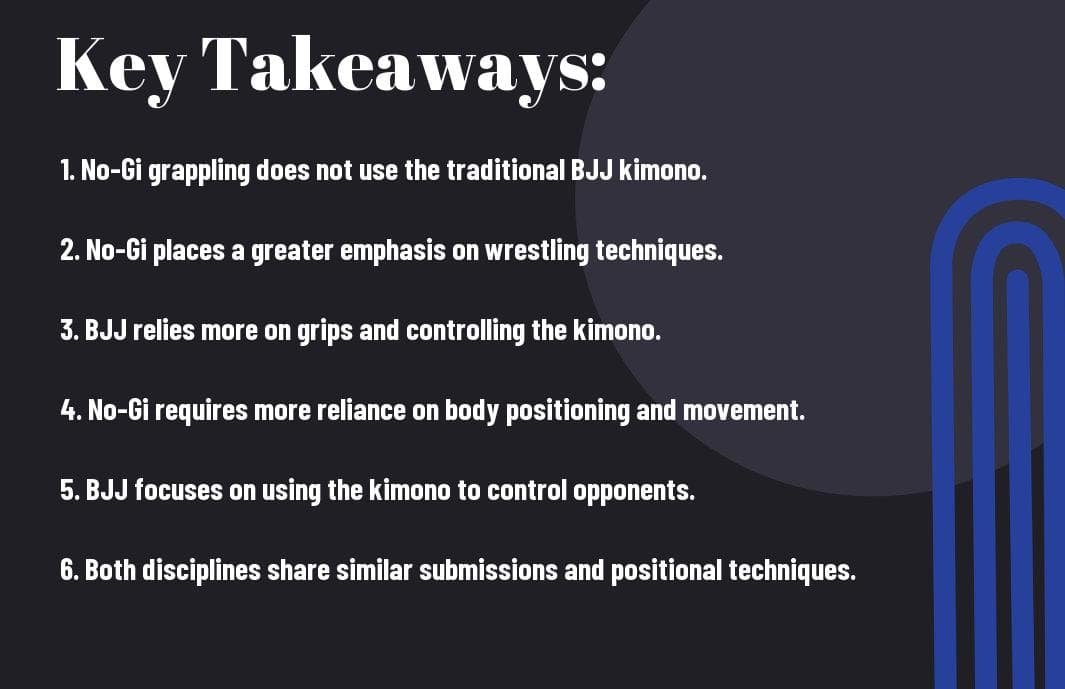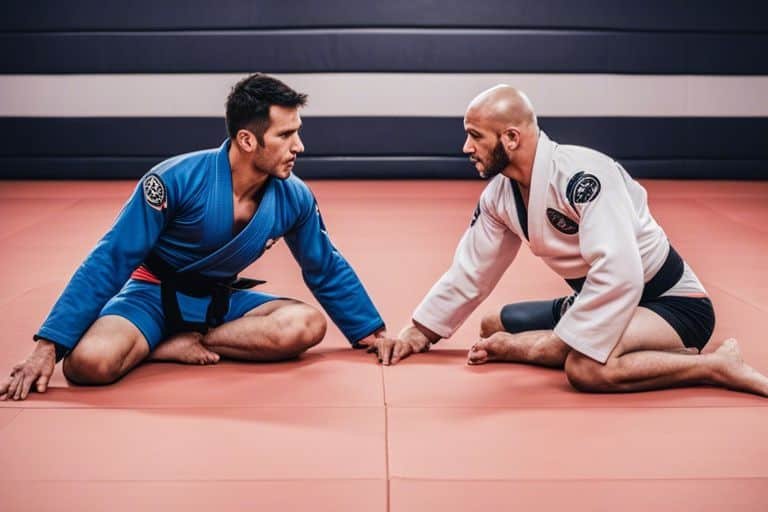Do you know how No-Gi Grappling differs from BJJ? If you’re a grappling enthusiast, it’s essential to understand the key differences between the two. No-Gi Grappling, as the name suggests, is performed without the traditional gi uniform used in BJJ, and this affects the techniques, grips, and overall strategy. To learn more about these differences, check out SABUL’s detailed comparison in their blog post Brazilian Jiu Jitsu Gi vs. No Gi Jiu Jitsu: What’s the Difference.
Key Takeaways:
- No-Gi Grappling focuses on technique and leverage: Without the traditional gi to grab onto, practitioners of no-gi grappling must rely on different techniques and leverage to control their opponents.
- No-Gi Grappling allows for more direct submission holds: With less fabric to grab onto, practitioners of no-gi grappling tend to focus more on chokes, locks, and other submission holds that can be applied directly to the opponent’s body.
- No-Gi Grappling requires a different level of speed and agility: Without the added weight and friction of a gi, practitioners of no-gi grappling must rely more on speed and agility to control and submit their opponents.
- BJJ often incorporates more intricate grips and controls: With the use of a gi, practitioners of Brazilian Jiu-Jitsu have the advantage of utilizing intricate grips and controls that are not available in no-gi grappling.
- No-Gi Grappling is more applicable to real-life self-defence situations: The lack of a gi in no-gi grappling makes it more applicable to real-life self-defence situations, as opponents are not likely to be wearing a gi on the streets.

The Fundamentals of No-Gi Grappling
No-gi grappling is a dynamic and versatile martial art that differs from traditional Brazilian Jiu-Jitsu (BJJ) in several key ways. In order to excel in no-gi grappling, it is essential to understand the fundamentals of this discipline and how they distinguish it from BJJ. In this chapter, you will explore the core techniques, strategies, attire, and gear differences that define no-gi grappling.
Core Techniques and Strategies
In no-gi grappling, you rely on your body’s natural movements and leverage to control and subdue your opponent. Unlike BJJ, where the use of a gi allows for grips and controls, no-gi grappling requires you to adapt your techniques to a more fluid and fast-paced environment. As such, your focus will be on developing a strong base of fundamental techniques such as takedowns, submission holds, and positional control. You will also need to master the art of using underhooks, overhooks, and body positioning to gain an advantage over your opponent. Building a solid foundation in these core techniques and strategies is essential in becoming a proficient no-gi grappler.
Attire and Gear Differences
One of the most apparent differences between no-gi grappling and BJJ is the attire and gear worn during training and competition. In no-gi grappling, you will wear form-fitting rash guards or t-shirts and compression shorts or spats, as opposed to the traditional gi worn in BJJ. The absence of a gi means that there are no grips and handles for you to utilise, forcing you to rely solely on your body’s natural attributes and techniques. Additionally, no-gi grappling generally involves a faster pace of combat due to the lack of restrictive clothing, requiring you to adapt and refine your movements accordingly. Understanding how the absence of a gi impacts your approach to grappling is crucial in succeeding in the no-gi discipline.
Comparing No-Gi to BJJ
When it comes to understanding the differences between no-gi grappling and Brazilian Jiu-Jitsu (BJJ), it is essential to take a closer look at the key elements that set them apart. Here’s a breakdown of how these two disciplines compare:
| No-Gi Grappling | BJJ |
| No uniform or kimono required | Traditionally practiced with a gi |
| Emphasis on speed and agility | Focus on technique and leverage |
| Greater reliance on strength and athleticism | Strategic use of grips and control |
Rule Variations and Scoring
In no-gi grappling, the absence of a gi means there are different rules regarding grips and submissions. Scoring also differs, with emphasis on positional control and submission attempts. This encourages a more dynamic, fast-paced style of grappling where you have to constantly adjust your strategy based on the flow of the match.
Importance of Grips and Control in BJJ
BJJ places a significant emphasis on grips and control, as practitioners use the gi to secure holds and create leverage. This often leads to a more methodical and strategic approach, where you have to focus on breaking your opponent’s grips while maintaining your own. The control and grip techniques in BJJ are crucial for setting up submissions and dominating your opponent on the ground.
Training and Competition
When it comes to training and competition in no-gi grappling, there are significant differences compared to traditional Brazilian Jiu-Jitsu (BJJ) with the gi. If you are considering transitioning to no-gi grappling or simply want to understand the distinctions better, it’s essential to be aware of the unique aspects of training and competing in this discipline. For a comprehensive breakdown of the differences between no-gi and gi Jiu Jitsu, you can refer to this detailed article on No-Gi vs. Gi Jiu Jitsu: Differences & Which to Choose.
Preparing for No-Gi Grappling Matches
When preparing for no-gi grappling matches, it’s crucial to focus on movement and agility. Without the gi to grip onto, your opponents will be quicker and more slippery, making it essential to have a strong understanding of body control and positioning. Additionally, you will need to place a greater emphasis on incorporating techniques that do not rely on gi grips. The speed of the game is also significantly faster in no-gi matches, making it imperative for you to be able to think and act quickly.
How BJJ Competitions Differ
In a BJJ competition, the use of a gi allows for a wider range of techniques and strategies, including the effective use of grips and chokes. In contrast, no-gi grappling competitions focus more on athleticism and speed, with a greater emphasis on takedowns and positional control. The absence of the gi also means that you will need to adapt your submission techniques, as certain submissions that rely on gi grips may not be as viable. Additionally, no-gi competitions often feature a wider range of leg lock submissions, adding an extra layer of complexity to your game.
Understanding the differences between training and competing in no-gi grappling as opposed to BJJ with the gi is crucial for your development in these disciplines. Each has its own unique challenges and rewards, and by adapting your training and competition strategies accordingly, you can excel in both realms. Remember, the transition to no-gi grappling may take some adjustment, but the broader skill set and increased athleticism it provides can be extremely beneficial in your overall development as a grappler.
Cross-Training Benefits and Considerations
When it comes to improving your overall grappling skills, cross-training between no-gi grappling and BJJ can offer you significant benefits. Not only does it provide you with a well-rounded understanding of various grappling techniques, but it also enhances your versatility on the mat. However, it’s crucial to consider the differences and challenges that come with cross-training in both disciplines.
Enhancing Versatility Through No-Gi Grappling
Engaging in no-gi grappling can significantly improve your versatility as a grappler. Without the presence of a gi, your movements become more dynamic and fluid, allowing you to develop a strong sense of body awareness and control. The emphasis on controlling and submitting opponents without the aid of traditional grips enhances your ability to adapt to different situations, making you a more well-rounded grappler overall.
Integrating BJJ Principles in No-Gi Contexts
When cross-training between no-gi and BJJ, you have the opportunity to integrate BJJ principles into a no-gi context. This allows you to refine your understanding of fundamental grappling techniques and principles, such as leverage, weight distribution, and submission holds. By applying these principles in a no-gi setting, you can develop a more comprehensive understanding of grappling and its application in various scenarios.
To wrap up
You now understand the key differences between no-gi grappling and BJJ. No-gi grappling involves techniques and strategies that are tailored specifically for the absence of a traditional gi, while BJJ incorporates the use of the gi as an integral part of its techniques. Understanding these differences will help you appreciate the unique challenges and opportunities that each form of grappling presents, and enable you to adapt your skills accordingly. Whether you choose to focus on one discipline or train in both, this knowledge will undoubtedly enhance your overall grappling expertise.
FAQ
Q: What is the difference between No-Gi Grappling and BJJ?
A: No-Gi grappling, also known as submission wrestling, is a form of grappling without the traditional uniform, or “gi”, used in Brazilian Jiu-Jitsu (BJJ). BJJ, on the other hand, incorporates the use of the gi in training and competition.
Q: Are the techniques different in No-Gi grappling compared to BJJ?
A: Yes, the techniques in No-Gi grappling often focus more on clinching, controlling the opponent’s body, and using leverage to submit them, whereas BJJ techniques may involve using the gi for grips and submissions.
Q: Is No-Gi grappling faster paced than BJJ?
A: Generally, yes. No-Gi grappling tends to be faster paced as there are fewer grips and opportunities to stall, leading to a more dynamic and fast-paced style of fighting compared to traditional BJJ.
Q: Can someone train in both No-Gi grappling and BJJ?
A: Absolutely. Many practitioners train in both No-Gi grappling and BJJ to develop a well-rounded skill set. Training in both can improve a grappler’s ability to adapt to different situations and opponents.
Q: How does the absence of a gi affect the strategy in No-Gi grappling?
A: Without the gi, No-Gi grappling requires more reliance on body control and positioning, as well as using underhooks, overhooks, and various other clinches to maintain control. This can lead to a more wrestling-based strategy compared to BJJ, which emphasizes use of the gi for grips and control.
Q: Are there specific rules or techniques unique to No-Gi grappling?
A: No-Gi grappling often allows for a wider variety of techniques, such as leg locks and certain takedowns that may be restricted in traditional BJJ competitions. This can make No-Gi grappling more unpredictable and dynamic in terms of techniques used.
Q: Does No-Gi grappling or BJJ have a more significant emphasis on athleticism?
A: While both disciplines require athleticism, the faster pace and reliance on body control in No-Gi grappling can make it slightly more demanding in terms of athleticism compared to BJJ. However, both disciplines require a high level of physical conditioning and skill.



